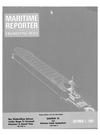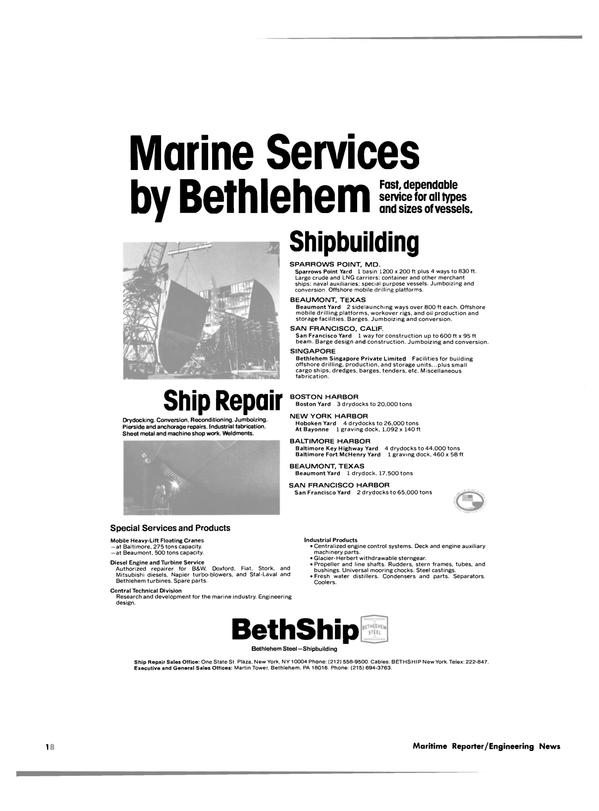
Christen First U.S.-Flag Freezer Ship For East Coast Operations
The first American-owned, U.S.- flag, oceangoing freezer ship designed to operate off the U.S.
East Coast was christened recently during ceremonies held at the New York Port Authority's Pier 1, Brooklyn.
The "Holland" (shown above) will offer a new service to the East Coast fishing industry, providing American fishermen with the opportunity to sell their catch at sea, and offering export markets the best-preserved fish products from this country.
The 151-foot-long Holland—the original version of this now fully refitted ship — was built in the Netherlands in 1964 as a wetfish stern trawler, and fished herring actively through the end of 1979, when she was removed from service after the collapse of the North Sea herring fishery. The boat was acquired under the subsequently enacted Dutch government policy of subsidizing the sale of such vessels outside the Common Market.
The Holland was converted at Oranjewerf Shipyard, Amsterdam, into a freezer ship/mother ship. The renovation included installation of a freezing capacity of 20 tons per day in two airblast freezers on the main deck, plus a supplementary freezer in the hold; the insulation of the fish holds to permit storing about 150 tons of frozen product below 0°F; installation of refrigerated seawater tanks on the aft deck to keep additional fish chilled prior to placement in the blast freezers ; the conversion of the electrical generating equipment to supply power to the refrigeration equipment, and the installation of new net-handling equipment.
The Holland will take delivery at sea of fresh-caught fish—usually squid and butterfish—from typical American fishing vessels by a procedure known as "cod end transfer." During the transfer procedure, the collecting end of the harvest ship's fishing net will be disconnected from the remainder of the net and reattached to a line from the Holland.
The Holland will haul the fish onboard and begin the freezing operation.
The frozen squid (calamari) will be marketed in southern Europe and the butterfish in Japan.
These catches should keep the Holland busy for five to six months each year. Then the vessel's capabilities will be employed in other fisheries such as sea trout, bluefish or croaker, or as a supplemental dockside freezer plant at any of the East Coast ports that do not presently have land freezers.
Despite being one of the richest and most abundant shorelines in the world—20 percent of the world's fish resources lie within the 200-mile limit — America's East Coast has yet to develop into a major exporter of fish products.
Among the reasons for this failure has been the long-standing inability of American industry to compete successfully with the large and efficient foreign factory ships which for years operated in U.S. waters.
The foreign advantage was tempered in 1976 with the passage of the Magnuson Fishery Conservation and Management Act that restricted foreign vessels.
Under its terms, American industry is given first call on the fishing harvest, with the remainder— the so-called Total Allowable Level of Foreign Fishing, or TALFF — allocated by the State Department only after U.S.
harvesting capacities are satisfied.
Read Christen First U.S.-Flag Freezer Ship For East Coast Operations in Pdf, Flash or Html5 edition of October 1981 Maritime Reporter
Other stories from October 1981 issue
Content
- French To Reopen Panama Ship Repair Yard At Balboa, Will Spend $10 Million page: 5
- ICC Grants Hunter Marine Regulated Cargo Authority For Western Rivers page: 6
- INMARSAT Set For February 1 Start page: 6
- Southside Marine Opens Newport News Branch page: 7
- New Brochure Describes Skagit Series 300 Cranes For Offshore Operations page: 7
- Program Finalized For Maintenance Seminar In New York October 28 page: 7
- Launch First Five-Screw Crewboat At Gulf Craft; Diesel Plant Modified By George Engine page: 7
- Submersible Drilling Barge "The Mr. Ray' Christened At McDermott Yard page: 8
- Tidewater Elects Bankston President, Koock, Ramey Are New VPs page: 8
- Crowley Establishes Unit For Energy Transportation Headed By VP Kirkeide page: 9
- Mrs. Joseph Elected Director At Twin City Barge page: 10
- Megasystems Cargo Control Systems Ordered For Product Carriers page: 10
- Dravo SteelShip Delivers The 'Mobilian' For Warrior And Gulf Navigation Company page: 11
- Norshipco Reactivates Mothballed Cargo Ship In Less Than Six Days page: 12
- Moss Rosenberg Delivers First Of Three Chemical/Gas Carriers For Norwegian Owners page: 12
- Progressive Delivers First Boat For Africa page: 12
- Floating Factory Completes Nine-Day, 2,500-Mile Voyage To Canadian Arctic page: 13
- Literature Published On Navigation Computer System From Trimble page: 13
- Savannah Shipyard Reports Passing Of David H. Green page: 13
- Bay Shipbuilding Names John Schermond New Manager Of Contracts page: 13
- Zapata Christens Three Offshore Drilling Rigs Built In Singapore page: 13
- Christen First U.S.-Flag Freezer Ship For East Coast Operations page: 14
- Bayou Black Delivers Sundance Sunset page: 14
- Administration Establishes Coal Export Working Group —Will Move 'Aggressively' page: 15
- Bay Shipbuilding Delivers The 'Energy Freedom'—First Of New Fleet Planned By Universal American page: 16
- McDermott Official Says Marine Building Outlook In Gulf Area Is 'Best Ever page: 16
- Two Brochures Available On Sperry's Doppler Speed, Navigation Systems page: 16
- SNAME Requests Technical Papers For 1982 Annual page: 16
- Five Executive Promotions Announced At Perko page: 16
- Bulletin From International Shows Performance On 400 Vessels Of SPC Coatings page: 17
- McAllister Names Alban Division Manager page: 17
- Research Continues For More Fuel Efficiency With Lower Grade Fuels page: 18
- Gastech '81 page: 19
- Award $2.9-Million Navy PSA Contract To Todd page: 27
- Avondale Christens The Oxy Grower page: 28
- Two-Ferry Modification Contract Worth $38 Million Awarded Burrard Yarrows page: 30
- Upward Trend Reported In World Orderbook page: 34
- ABS Sets Procedures For Survey Requirements Of New Int'l Agreement page: 34
- New Underwater Vehicle From Hydro Operating For Santa Fe Diving page: 40
- LOOP Shakedown Smooth, Handles Seven Large Tankers Without A Hitch page: 41
- P.T. Indospec Formally Recognized As Certification Agency In Indonesia page: 41
- Houlder Orders Jackup For Morecambe Bay Gas Field For $37-Million page: 42
- Hydranautics To Provide Skidding System For Perforadora Mexico S.A. page: 42
- WATERCOM Files Application For Automated Waterway Communications System page: 43
- Far East-Levingston Upgrades Facilities page: 44
- Burrard Yarrows To Build $29-Million Supply Vessel For Use In Beaufort Sea page: 46
- Hydranautics Provides Skidding Systems For Jackups Apollo III, IV page: 46
- MarAd To Fund Installation Costs For Defense Radio Gear On Merchant Ships page: 48
- Design Semisubmersible For Use In Arctic Ice Conditions page: 48
- Halter To Build Two Supply Vessels For Jackson Marine page: 51
- Canadian Firm Orders Four Large Bulk Carriers page: 52
- Seaward International Awarded Fourth Fendeir Contract By U.S. Navy page: 52
- Ashland Oil Will Use Megasystems D.O.T. Unit To Evaluate Additives page: 52
- IHI To Build World's First Mobile Arctic Caisson Rig For Beaufort Sea page: 55
- Jeffboat Launches First Of Two 250-Foot Tank Barges For Boston Fuel page: 56
- Fifty-Year-Old Tug Is Restored For Service page: 56
- George Engine Reports Record Growth-Sales —Brochure Available page: 56
- J a p a n To Spend One Billion Dollars To Upgrade Shipyards page: 57
- DOT Approves License For Deepwater Oil Port Offshore Texas page: 57
- $3-Million Navy Contract Awarded To Tracor page: 57
- City Of Valdez, Alaska Awards Contract For Container Terminal page: 58
- Unified Navigation Rules Published For U.S. Waterways page: 58
- Christen Navy Hydrofoil 'Aquila' —Third Of Six Missile Ships Building At Boeing Marine page: 58
- HUDSHIP To Build Four Tug/Supply Vessels For Hornbeck page: 58
- 4,000-Ton Drydock 'H.S. Geneen' Ch ristened At Delta Shipyard page: 58
- Levingston Delivers Dixilyn-Field 87 page: 58
- New Dredging Unit Being Built For Use On Tenn-Tom page: 60
- CAT Offers 20-Page Guidebook For Diesel Engine Selection page: 60
- Bergeron Plans New Yard To Build Hopper Barges page: 62
- Publish Radiotelephone Handbook For Mariners page: 62
- Moss Point Y a r d Delivers Two Supply Boats page: 64
- M a r i n e A p p l i c a t i o n Of C l a y t o n S t e am Generators S h o w n In Free Brochure page: 64
- Brochures Available On New Line Of Twin Disc Marine Transmissions page: 66
- Canadian Firms Order Two Semisubmersibles In $300-Million Order page: 66
- Tacoma Boat To Build Four Voith Schneider Equipped Tugs For Foss Launch page: 67
- Halter Signs Contracts To Build Six Additional Vessels For Petromar Fleet page: 69
- New Marine Lifting Equipment Code Published By LR page: 70
- Elect E.B. Peebles Jr. New President Of Ryan-Walsh Stevedoring page: 71
- B&W Offers Technical Paper On Advantages Of New Low-Speed Diesels page: 71
- Soviets Award $120-Million Contract To Valmet For Two Arctic Cargo Ships page: 72
- South Korea To Build O wn Semisubmersible Unit To Cost $80 Million page: 73
- Northern N e w England A S N E Appoints Councilman, Sets M e e t i n g Schedule page: 73
- Guralnick Associates Receives OTEC Contract page: 74
- GECC Names Gary Wendt VP For Commercial And Industrial Financing page: 74
- Auxiliary Sail Rig Passes Sea Tests On Cargo Ship page: 75
- Approve $16-Million MarAd Title XI Guarantee For Coal-Carrying Barge page: 75
- Halter Completes Diesel Electric Supply Boat Contract For Acadian page: 76
- Megasystems Combustion Analysis Systems Ordered By Phillips page: 76
- $35.8-Million Contract Awarded To Build New Lock On Gulf Waterway page: 76
- 135-Page Full-Color Catalog Available On Limitorque Actuators page: 77
- $55.6-Million Arctic Research Center To Be Built In Newfoundland page: 78
- UPSCO Names Shakshober VP-Design & Engineering page: 78
- Launch Largest Car/Passenger Ferry At Gdansk Shipyard page: 79
- A Preview EXTREME LOADS RESPONSE Symposium page: 80
- Construction Begins On New Super-Class Semisubmersible For ODECO page: 84
- Port Of Portland Approves $60-Million Coal Terminal page: 85
- B&W Alpha Diesel Names Midland As U.S. Reps For Inland Waterways page: 86
- Cutter Suction Dredge Modified For Work On Tenn-Tom Waterway page: 86
- Product Carrier Philadelphia Sun Joins Sun Transport Fleet page: 87
- Todd To Move 'Frisco Drydock, $40-Million Syncrolift Being Built For Los Angeles Yard page: 87
- Krupp Completes Two Of Four Pusher Tugs For Nigeria page: 88
- First Jackup Unit For U.S. Completed By Hitachi Zosen page: 88
- Western Gear Offers Brochure On Propulsion Drives For Mobile Rigs page: 102
- Racal-Decca Marine Moves Sales And Marketing Group To Seattle Location page: 102


